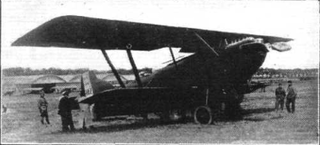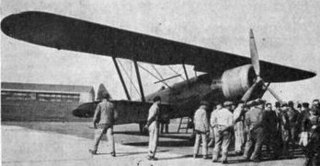
The Morane-Saulnier MoS-121, also known as the Morane-Saulnier MS.121, was a fighter prototype designed and produced by the French aircraft manufacturer Morane-Saulnier. It was the company's first fighter design after the First World War.

The Latécoère 350 was a trimotor development of the Latécoère 28, a successful single-engined French monoplane of around 1930. The three engines were intended to provide the reliability needed for overnight flights, but the 350 came out very overweight. Only one was built.
The Latécoère 550 was a four-engined French seaplane, designed in the early 1930s as a bomber/torpedo bomber. Though initial handling problems were partly resolved, the aircraft was deemed too slow and did not go into production.

The Dyle et Bacalan DB-10 was a heavy night bomber, designed in France and flown in 1926. It was a twin engine, high wing, metal frame monoplane, distinguished by a very thick centre section wing which formed the forward fuselage and housed the engines.

The Potez 37 was a two-seat, long range reconnaissance aircraft built to compete for a French government contract. It flew in mid-1930 but did not win the competition, so only two were completed.

The Nieuport-Delage NiD 48 was a single-engine parasol wing light fighter aircraft designed and produced by the French aircraft manufacturer Nieuport-Delage.

The Wibault 2, Wib 2 or Wib 2 BN.2 was a single engine biplane aircraft designed and built in France in the early 1920s. It was intended as a heavy night bomber, though a thirteen-seat passenger version was proposed. Only one was built.

The Hanriot HD.15 was a French two-seat fighter aircraft fitted with a supercharger for good high altitude performance, built in the 1920s. Three were ordered by Japan but lost at sea during delivery.

The Potez 28 was a French aircraft designed in the 1920s to set distance records, built in both sesquiplane and monoplane versions. Only two were completed but both set several long distance records.

The Potez 31 was a prototype French two-seat night fighter, flown in about 1928, intended to fill the Cn.2 specification for the Armee de l'Air. Only one was built.
The Potez 27 was a French reconnaissance biplane first flown in 1924. 175 were operated by the Polish Air Force, most built in Poland by PWS under licence. Others went to Romania, where they were also used as light bombers.

The Les Mureaux 3 C.2 and Les Mureaux 4 C.2 were French two seat, parasol winged fighters, flown in 1927-8, which differed only in their engines. They were developed into near identical army co-operation types, the ANF Les Mureaux 130 A.2 and ANF Les Mureaux 131 A.2, in 1929–31.

The Aviméta 88 was an all-metal French two-seat reconnaissance-fighter or heavy fighter tested in 1927.

The Villiers IV or Villiers 4 was a French two seat naval floatplane. Two were built, the first with twin floats and the second with one. The first was short-lived but the second set several world and national records; it later became the Villiers XI.

The Caproni Ca.95 was a large, three engine, long range, heavy bomber prototype built in Italy in 1929. It could carry a 1,600 kg (3,500 lb) bomb load and had three defensive gun positions. Only one was built.

The Potez 50 or Potez 50 A2 was a French two seat military multi-role aircraft, first flown in 1931. It did not go into service but seven variants using five different engines were produced, one of them setting several speed with useful load records and another, the Potez 506, setting three altitude world records.

The Wibault 260 R.2 was a contender for a French government contract for a long range, two seat reconnaissance aircraft, issued in 1928. There were eight prototypes in the 1931-2 contest and the Wibault was not selected for production.

The Nieuport-Delage NiD 580 R.2 was a contender for a French government contract for a long range, two seat reconnaissance aircraft, issued in 1928. There were eight prototypes in the 1931-2 contest and the NiD 580 was not selected for production.
The Caproni Ca.66 was an Italian night bomber designed to reequip the post-World War I Italian Air Force. Only two examples of the four-engined biplane were built.
The CPA 1 was a French twin-engined, parasol-winged bomber designed and built in the mid-1920s.

















